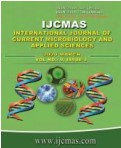


 National Academy of Agricultural Sciences (NAAS)
National Academy of Agricultural Sciences (NAAS)

|
PRINT ISSN : 2319-7692
Online ISSN : 2319-7706 Issues : 12 per year Publisher : Excellent Publishers Email : editorijcmas@gmail.com / submit@ijcmas.com Editor-in-chief: Dr.M.Prakash Index Copernicus ICV 2018: 95.39 NAAS RATING 2020: 5.38 |
Readability formula is a predictive device to determine the extent of readability of selected written material in general and agricultural publications in particular. The foremost purpose of every readability formula is to serve as a good yardstick to measure the readability level of the passage analysed and also to provide guidelines and procedures for the writers to make their writing readable. With this purpose in view, readability formula was specifically developed for the study. The developed readability formula was found appropriate to describe in detail the norms of distribution of the three readability variables with reference to different school levels. Word length, Average sentence length and Percentage technical words were the readability variables selected for the study. The norms of distribution in terms of mean, standard deviation and range of the three readability variables are presented for three categories viz., Primary school, Middle school, and High school level. Further it was also essential to know the relationship between the readability formula developed and the earlier formulae developed in Kannada language. For this purpose, 20articles were selected from KrishiVignana journal for illustrating the application of present formula and analyzed using the earlier readability formulae. Results revealed that there was a significant relationship between the developed readability formulae with the readability formula developed by earlier social scientists. The formula will be particularly helpful for prior testing of written material before publishing it for the benefit of readers in general and farmers in particular. The norms of distribution developed will be helpful to comprehend more accurately which type of words and sentence they can use while writing for a particular type of readers.
 |
 |
 |
 |
 |